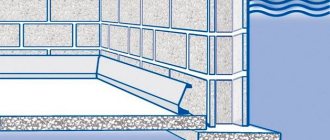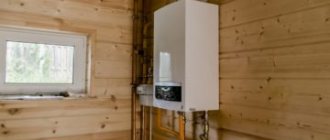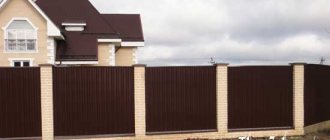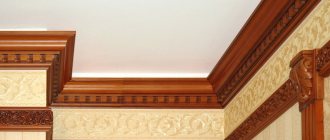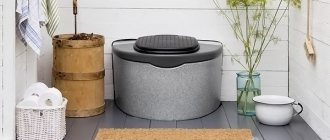Selecting lining for the ceiling
More recently, when it came to ceiling lining, it was wooden figured strips that were meant. However, currently the construction market offers several types of lining. Based on the intended purpose of the room, material capabilities and buyer preferences, you can choose one or another material.
The material for making lining can be:
- wood;
- polyvinyl chloride;
- MDF boards.
It is worth going into more detail on each of the materials.
Beautiful examples
To have a clear idea of the stylish and attractive interior of a living room in an apartment or cottage, you can look at examples from the photo gallery made by professional specialists.
A loft-style living room with panoramic windows, made in sandy-gray tones of the palette, looks stylish: the gray color of the floor and furniture stands out against the background of brick walls, tables and carpeting.
The cozy beige-coral living room in the contemporary spirit is very hospitable: the decoration of the guest area is a corner sofa with bright decorative pillows, next to it there is an original coffee table and cubic poufs.
A guest area in grunge style can be placed by the fireplace: place furniture in front of it, complement the guest space with a round coffee table, and decorate the walls with a couple of paintings.
A living room in the brutalist style looks stylish and unusual: paintings in a single theme against the background of a concrete wall fit well into the interior of the space and are emphasized by the identical color of the frame of the panoramic window, stylish sofas by the fireplace contribute to a hospitable atmosphere.
Comfortable living room in lounge style: in addition to a soft corner sofa with a variety of pillows for a comfortable position, the furniture is complemented by a pair of sets in the form of a cozy armchair and a soft leather stool to provide guests with maximum comfort.
And in the next video you can get acquainted with current living room design ideas.
Wooden lining
When finishing the ceiling with wooden paneling, the natural rustic style of the room is preserved. Wood lining is used in premises for any purpose and is absolutely safe for human health. The price of this building material varies depending on the type of wood. Most often, lining is made from alder, cedar, fir, oak, aspen, larch and other types of wood.
Pine has antiseptic properties because it is rich in resins. These substances cause mold to form on the surface of the lining. In addition, pine itself is considered a fairly smooth tree, with a small number of knots, which makes it ideal for creating lining.
Lining made from coniferous wood is considered almost universal, unlike hardwood, which is used mainly indoors. However, any wood is susceptible to moisture, so it must be impregnated with special products and provide air access to ventilate it.
Depending on the quality of the wood, there are 4 types of lining:
- Top class (extra). This board looks perfect in appearance, there are no chips, dents or cracks on it. The price of such material is very high, since it is made by splicing. At high humidity, this material begins to crack, so this lining is not used in damp rooms.
- Class A. Small knots are allowed, but there are no other defects on such material. As a rule, it is this category of lining that most consumers choose.
- Class B. There may be small defects on the surface of the board. Although such lining is usually not used in residential premises, it is best suited for cladding balconies and country houses.
- Class C. This is the lowest grade material, which has a large number of knots and defects.
Characteristics of MDF lining
In appearance, a ceiling made of MDF paneling resembles a wooden laminate, although this material is, in fact, a board made of pressed sawdust. This material is very sensitive to moisture. At the slightest contact with water, it begins to swell, losing its appearance and original quality.
It is worth noting that MDF paneling is used more often for walls than for ceilings. It allows you to organize various decorative elements and diversify the interior. In addition, the material has high thermal and noise insulation qualities.
If desired, you can combine MDF lining with different colors and textures. Installation of such material is not difficult.
Features of polyvinyl chloride lining
Covering the ceiling with PVC lining is an excellent option, since the material is very easy to handle and easy to install. However, it is worth remembering that PVC planks are fragile and very easy to damage.
There are two types of PVC lining:
- with seams;
- seamless.
Seamless lining allows you to create an almost seamless, smooth surface on which the seams between the individual planks will be almost invisible. If you want to create a surface reminiscent of eurolining, you should use panels with seams.
One of the main advantages of polyvinyl chloride panels is that they are resistant to wet environments. However, you should avoid exposing such a ceiling to direct sunlight, since under ultraviolet radiation the lining will begin to lose its original color.
Thus, the best options for finishing the ceiling with clapboard would be plastic (PVC) panels, as well as wooden planks.
Turquoise
Meaning
The turquoise color is the result of mixing green and blue. In the environment, it occurs in the form of sea waves and chrysocolla, a mineral known for its magical properties.
Turquoise has the following characteristics:
- calm;
- harmony;
- privacy;
- innocence;
- luck;
- well-being.
Even at the wedding ceremony, Muslim girls wear a turquoise dress, wanting to live a happy and long life with their future spouse.
Influence
Surprisingly, the turquoise hue has only a positive effect on a person’s psychological state. Whatever your state of mind, aquamarine eliminates stress and anxiety.
You remember that turquoise combines two calm and serene colors. The result of this combo is a shade that has all the characteristics of green and blue. It will help a person restore his strength, improve his health and find a way out of a difficult situation.
People who try to surround themselves with the color turquoise are very creative and inventive. They are romantic, dreamy, and able to see beauty in everything. Very often these people connect their lives with art, becoming designers.
Interior
Azure decorates the space in the interior, filling it with harmony. Turquoise will show its qualities best when paired with:
peach;
lavender;
bronze;
white;
lemon;
malachite.
Turquoise looks impressive both in combination with warm contrasting shades and dark tones. Add more bright colors if you feel that the abundance of azure is too calming. Contrasting accents will lift you out of your melancholy state and encourage you to take action.
Material calculation
Before covering the ceiling with clapboard in a wooden house, you should take care of purchasing a sufficient amount of material so that during the work you do not need to take breaks for additional purchases. The standard dimensions of one lining board are 15 cm wide, 600 cm long and 1.2-2.5 cm thick. These are the requirements of GOST 8242-88.
For interior decoration, panels with a thickness of less than 1.6 cm are used, and for exterior decoration, panels with a thickness of 1.8 cm or more are used. To determine the number of boards for finishing the ceiling with eurolining, you need to calculate the area of 1 plank and compare it with the total area of the surface to be sheathed. Thus, if we take a panel 9.5 cm wide and 6 m long, its total area will be 0.57 m2.
Let's assume that the total ceiling area in the room is 9 m2. Then for work you will need 9÷0.57=17.3≈18 boards. This is the minimum number of panels, since during the cladding process the width of the canvas will be reduced due to the peculiarities of the installation of the lining. It is fastened with a comb into the groove.
Design tips
In order for the living room interior to be harmonious, cozy and visually attractive in any chosen style, it is worth taking note of a few recommendations from experienced design stylists:
- when purchasing wallpaper, choose between non-woven, vinyl with silk-screen printing, textile, liquid varieties or glass wallpaper: they are practical, easy to paste, stay on the walls for up to 15 years or more, and allow the surface to be cleaned;
- It is unacceptable to cover all the walls of the living room with the same wallpaper: accents are needed, so it is advisable to allocate one part of the wall for zoning the guest area;
- When using wallpaper with imitation brickwork in decoration, do not emphasize the style on more than one wall and a small area of the other: this can overload the interior;
- use shelving to decorate the space: today they are a stylish addition to the design, especially if the shelves are illuminated;
- do not use paintings or photos in black frames for design: there is no need to fill the space with mourning themes;
- take into account stylistic features, correlating them with financial capabilities: do not clutter the room with accessories that are inappropriate in each specific case;
- so that a spacious room does not seem empty, support its furnishings with the correct size of furniture: the more space, the more spacious the sofa and armchairs, the more additions (possibly two tables, additional sofa accessories, poufs, modular furniture);
- do not create pomp where there is a minimum of space and air is needed: massiveness is reflected in the heaviness of the situation, which will deprive the room of a feeling of comfort.
Dark shades demonstrate the boundaries of the room well; if it is small, this will enhance the perception of limited footage. By using light colors for decoration, you can visually erase the boundaries of a small space.
If the room is small, decorate it with a mirror (for example, on the front of a closet), this will significantly increase the visibility of the space. For the same purpose, you can use glass, using it as a tabletop for a coffee table or a side table. This material is able to visually fill the room with lightness and airiness, even if it is painted in a dark color.
Material quality control
After you have decided on the type, color, and quantity of the lining and delivered it to the work site, you need to check its quality. All panels should be laid out on a horizontal, flat surface and checked to see how well they correspond to the stated characteristics. Sometimes unscrupulous sellers place defective samples inside the packaging to avoid losses due to their rejection. Of course, it is advisable to pay attention to this during the shopping process in the store.
The next step if you plan to work with wood paneling is to dry it. PVC and MDF panels do not require this manipulation. To prevent the wooden lining mounted on the ceiling from becoming deformed, it must be thoroughly dried on a horizontal surface. The minimum drying period is 2 weeks, but a longer interval is allowed. If you do not want the wooden ceiling lining to soon lose its presentable appearance, drying cannot be neglected.
Preparation of tools and materials
To install the lining on the ceiling as quickly as possible, it is worth preparing in advance all the tools that may be needed during the work process:
- a hammer drill with a drill with a cross-section of 6-7 mm (if you have to work with a concrete ceiling), or an impact drill;
- screwdriver;
- electric jigsaw or hacksaw (tools are suitable for any type of lining);
- level;
- roulette.
In order to cover the ceiling with clapboard, you will need to purchase a number of auxiliary materials.
Since the lining is attached to the frame, that is, the sheathing, you need to choose the type of material for it:
- Wooden slats - they are best suited for fixing any type of lining, since working with them is easier and more convenient, and their cost is much lower than metal profiles.
- Metal lathing made of steel profiles. It is usually used for fastening plasterboard sheets.
It is worth noting that for working in rooms with high humidity, it is recommended to choose a steel version of the lathing and PVC lining, since they do not deform under the influence of moisture, unlike wood.
For a wooden frame you will need:
- strip 4x4 cm based on surface area;
- wooden or plastic wedges for the frame;
- brackets;
- self-tapping screws
For metal sheathing you need to purchase:
- steel profiles;
- fasteners;
- pendant;
- self-tapping screws;
- anchors.
You can begin installing the lining on the ceiling after purchasing materials and thoroughly drying the wood.
Preliminary work with the ceiling
It is very important before making a lining ceiling to prepare it correctly. First, you need to remove a layer of old plaster from the ceiling surface and clean the surface from dirt so that it is as smooth as possible.
Next, we proceed to marking the ceiling for the frame. In this case, it is worth deciding on the direction of the lining strips. In the process of further laying the lining on the ceiling, it is advisable to place it so that there are as few end joints as possible.
Since wooden elements are susceptible not only to moisture, but also to mold, they must be coated with an antiseptic before installation.
In private houses, the ceiling should be pre-insulated. A layer of thermal insulation is laid between the profile posts, mounted with an indentation of 50-60 cm. If we are talking about an apartment, then additional thermal insulation is not needed.
Next, we find a level for attaching the sheathing. Having decided on the direction of the slats, we mark the ceiling. Please note that the lining is fixed perpendicular to the sheathing beams. If desired, it can be placed at right angles to the walls or diagonally.
Retaining brackets are fixed to the ceiling with equal intervals between them. Then wooden slats are laid on the brackets, leveling them using small wedges.
In order for eurolining ceilings to be beautiful, the lathing must be installed very carefully and perfectly level.
The maximum step between fasteners is 50 cm. If eurolining is used, then the step must be halved.
Its final appearance and durability depend on how carefully you pay attention to the preliminary preparation of the ceiling.
Attic
It is traditionally believed that it is quite difficult to make an attic room spacious and bright - there are few windows, sloping walls and a small ceiling greatly limit the designer’s imagination. But in our photo you can see that the lining in the attic interior looks just right. The horizontal arrangement of the boards expands the space. A narrow board was used on the walls, and a wide one on the floor. This technique helps break the monotony of lines and move accents from main surfaces to interior items. The white color of the boards makes the room lighter. As you can see, painting the lining inside the house (the photo of the interior clearly demonstrates this) is of great, and in some cases, decisive, importance when adjusting the interior space.
Fastening the lining
Installing lining on the ceiling with your own hands is not something too difficult; even inexperienced performers can do it. True, it is advisable to work with the paneling together to make it easier to fasten long panels.
We begin to attach the lining to the ceiling with our own hands, perpendicular to the sheathing from the wall. The first board is tightly fixed to the wall with a tenon. Using a level, adjust the position of the board and then secure it. To lay the lining, you can use both small nails and clamps. In those rooms where the design of the lining ceiling should be ideal, clamps are used, and in other rooms, ordinary nails are also suitable.
Then we take the next board and insert it with a tenon into the groove of the previous one. At the points of contact between the panel and the sheathing, we firmly fix the board. We fix all other lining panels onto the battens in the same way.
On the opposite wall, the last strip of lining may need to be trimmed. In this regard, it is advisable to place it in a place where it will be least noticeable. When working with plastic panels, it is better to use a hand saw, while wooden lining and MDF panels are easier to cut with a jigsaw.
It is better to make any holes for wiring or mounting lighting fixtures immediately at the time of fixing the lining, so as not to damage it.
If you use nails to cover the ceiling with clapboard yourself, then you must first cut off their heads. At the end of the work, the nail holes are opened with wax.
The final stage of arranging a lining ceiling will be attaching the baseboards around the perimeter of the room. These decorative elements will add completeness to the ceiling and hide the gaps along the edges. Typically, wooden lining is opened with varnish, and baseboards with a darker stain and varnish. If desired, this ceiling can be painted.
Beautiful interior examples
In this version of the bedroom-living room, most of the wall is light, and the smaller part has multi-colored thin stripes. This combination looks very elegant. A low object was used for zoning. The decoration of the space is provided by colored pillows on the sofa. Residents will definitely like the glossy stretch ceiling. But in this room a different approach is taken:
- an attractive black and white painting on the wall;
- general black and white color scheme;
- shelving for dividing a room;
- nice dark gray lamp on the bedside table.
To learn how to combine a bedroom and living room in one room, see the following video.
A few recommendations for ceiling cladding
Here are some useful tips that may be useful to you:
- Before covering the ceiling with eurolining, it is advisable to check how good the electrical wiring and other communications running under the ceiling are. If in the future you have to dismantle the lining for repairs, it can be damaged.
- The ceiling lining in places of contact with electrical wires must be insulated to prevent fire.
- When working with wooden panels, it is advisable to use fasteners that will not rust. For PVC panels, the type of fastening is not important.
- Ceiling covering should be done in a dry room at a temperature not lower than 10 ℃.
The cost of a lining ceiling
The final cost of ceiling repair will largely depend on the price of materials. In turn, the price of lining varies depending on the type and species of wood, the length of the board, as well as production technology.
Depending on these factors, lining is divided into several categories by price:
- The most expensive is considered to be lining made of soft hardwood. Their processing is carried out in accordance with European standards.
- Hardwood lining falls into the middle price category.
- Lining made from softwood is the cheapest.
In addition, if you want to equip a two-level ceiling made of clapboard, you may have to invite a specialist, whose services you also need to pay for.
How to care for the ceiling
If we are talking about lining made of wood, it must be treated with antiseptic impregnations and primers that slow down the destruction of wood and prevent the development of fungus and rotting. When choosing a specific product, pay attention to its color, which should match the desired result.
Alternatively, wooden panels can be coated with a special oil, varnish or paint of your choice.
The processing option depends only on the wishes of the owner. In order for the ceiling to retain its presentable appearance longer, it is advisable to periodically wipe off dust from it. If just a damp cloth is not enough for cleaning, you can use special household products that are sold in large quantities in supermarkets.
"Golden Rule
It’s not enough to figure out which colors go best with each other. It is also necessary to know the correct proportion in which the interior as a whole will look balanced and harmonious. There is a “60/30/10” rule that always works great. This rule will help you correctly combine three colors in the interior. 60% should be occupied by the main color, mainly calm colors that predominate in the design of walls or furniture. 30% is an additional color. It is this 30% that your contrasting wall in the interior should occupy! 10% is an accent that can be present in the form of pillows on the sofa, vases, paintings or other small things. Using colors in such proportions will calm your interior.
hot seem closer
The article was written for the site remstroiblog.ru.

